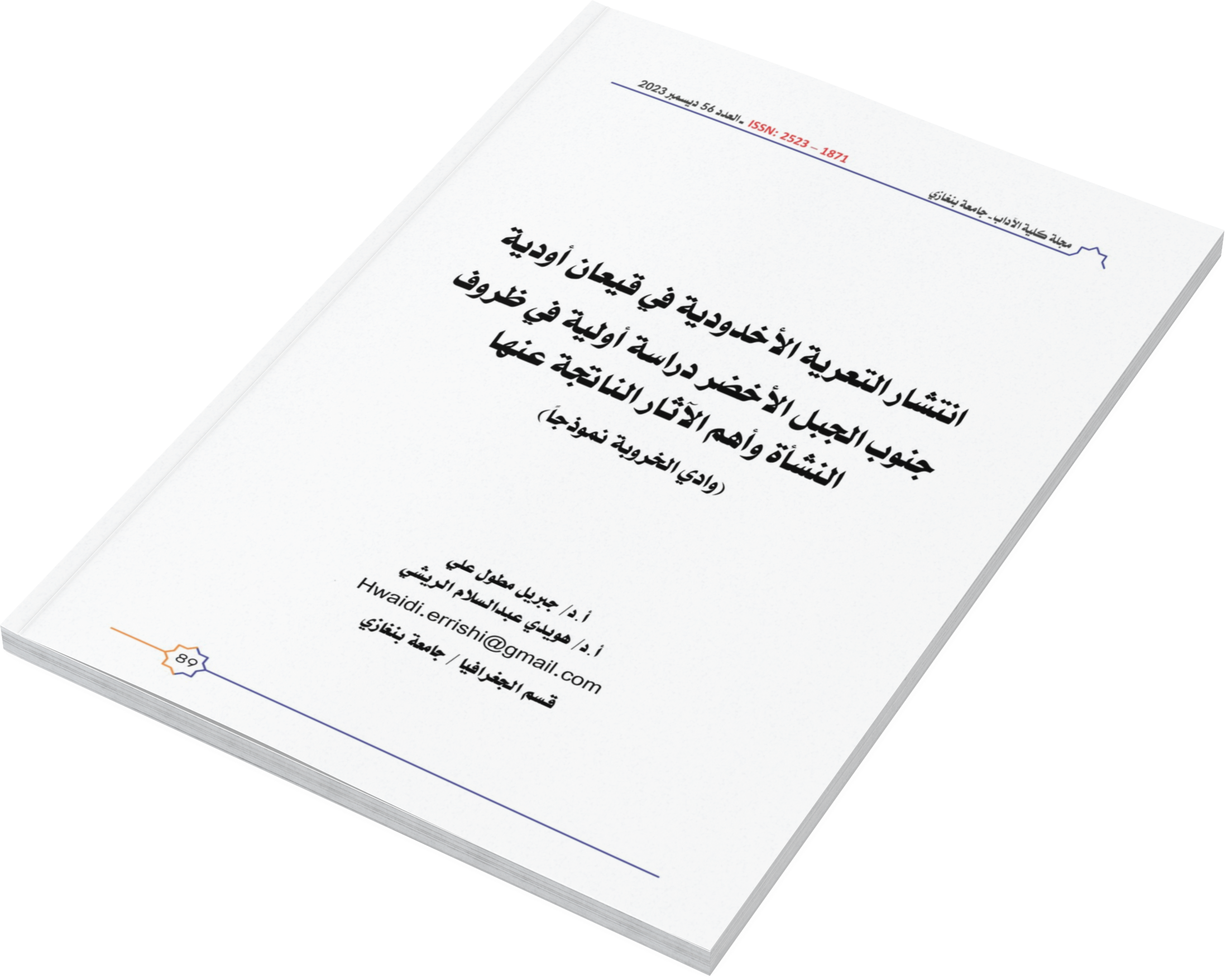انتشار التعرية الأخدودية في قيعان أودية جنوب الجبل الأخضر دراسة أولية في ظروف النشأة وأهم الآثار الناتجة عنها
وادي الخروبة نموذجاً
DOI:
https://doi.org/10.37376/jofoa.vi56.5921الملخص
The south slope of Green Mountain includes the land extending from the water division line to the south towards the flat plains called locally "Al-Balt". The slope cuts through many valleys, such as Wadi Al-Kharoubah, where most of them end in the lands of Al-Balt. The importance of the slope lands lies in the dependence of a large sector of the population on them for grazing and traditional agriculture, especially in the bottoms of the valleys where sedimentary soil and pasture grasses are available. As for the slopes of the valleys and the highlands between them, they are mostly poor and deteriorating lands. Due to the climatic conditions of these lands, characterized by low and irregular rainfall rates, their ecosystems have been fragile and susceptible to environmental degradation. With the continuous expansion of agricultural and pastoral activities, the delicate balance of these systems has been disrupted, and signs of deterioration have appeared, such as the spread of gully erosion along most of their drainage channels. The continued spread of gully erosion poses a threat to the productivity of these lands and the continued reduction of grazing and agricultural areas. This study aims to identify the causes of the formation and persistence of these gullies and the resulting deterioration in soil productivity and decrease in grazing and traditional agricultural areas. It also aims to determine the reasons for the inefficiency of existing erosion control measures. This study relied on measurements conducted in the field to determine the lengths, average depths, and widths of the gullies, as well as the width of the valley channel. This was done through stations located 100 meters apart from each other. These measurements were used to determine the area of land affected by gully erosion and the amount of soil erosion. The limitations of erosion control measures were determined through field observations. The study found that the spread of gully erosion in Wadi Al-Kharoubah was mainly linked to changes in surface flow properties, which increased in volume and velocity as a result of the deterioration of vegetation cover in the basin due to overgrazing and the expansion of rain-fed agriculture. The absence of regular monitoring of the effectiveness of protective measures, such as check dams, in terms of maintenance and repair, as well as the lack of attention to the management of natural pastures and the rehabilitation of natural vegetation cover, also contributed to the spread of the gullies.
التنزيلات
المراجع
- Cook, U. R. and Reeves W. R. (1976) Arroyos and Environmental Change in the American South-West. Clarendon Press, Oxford.
- Foth, H.D and Turk L.M. (1972) Fundamentals of soil science. Wiley and Toppan .
- Industrial Research Centre (1974) Geological map of Libya 1:250.000, Sheet: Darnah NI34-16. Tripoli.
- Boardman, J., Dearing, J. & Foster, I. (1990 Soil erosion studies; some assessments. In Boardman, Foster, I.D.L. and Dearing, J.A. (eds) Soil erosion on agricultural land. Wiley, Chichester, 659 – 105.
- Imeson, A.C. and Emmer, I.M. (1992) Implications of climatic change on land degradation in the Mediterranean. In Jeftic, L., Milliman, J.D. and Sestini, G. (eds) Climatic change and the Mediterranean. Edward Arnold, London, 95-128.
- Richter, G. and Negendunk, J.F.W. (1977) Soil erosion processes and their measurement in the German area of the Moselle river. Earth Surf. Proc. 2, 261-278.

التنزيلات
منشور
كيفية الاقتباس
إصدار
القسم
الرخصة
الحقوق الفكرية (c) 2024 مجلة كلية الاداب

هذا العمل مرخص بموجب Creative Commons Attribution-NonCommercial-NoDerivatives 4.0 International License.




